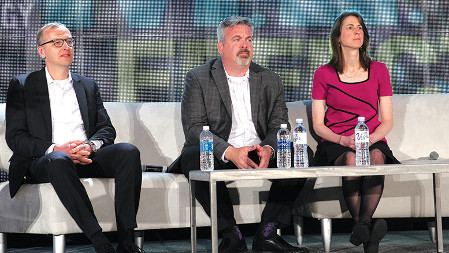Industry Is Ultra Bullish About Ultra HD
LAS VEGAS—Mass consumer adoption of Ultra HD is still out on the horizon, but the various facets that make up the broadcast and video industries are busily preparing today for what they see as a promising future for the next-gen video format.
“The demand is there [for UHD] and the industry is excited to fulfill it,” said Madeleine Noland, consultant with LG Electronics and an executive representing the Ultra HD Forum, during Monday’s Super Session “Ultra HD Broadcasting Comes of Age.”

From left: Hanno Basse, Pete Sockett and Madeleine Noland
“UHD is going to take off. The signs are all there,” she said.
Among those signs are the raw numbers and adoption forecasts. The Consumer Technology Association announced earlier this year that the rate of adoption of Ultra HD-capable TVs has already surpassed that of HDTV sets. The CTA expects 15 million UHD sets to be sold in the United States by the end of 2017, and 24.5 million by the end of 2020.
Other organizations, media giants and broadcasters are already putting their weight behind Ultra HD and the various next-gen video and audio aspects that will underpin it, including 4K resolution, wide-color gamut and high dynamic range.
But UHD devices, UHD distribution ecosystem and content must all work together hand in hand.
UHD TV adoption is growing, but there’s a “little bit of a lag” when it comes to the amount of content that is available in the format, said Hanno Basse, chief technology officer of 20th Century Fox Film Corp., and president and chairman of the UHD Alliance. “But we’re working hard to close that gap.”
Fox, he pointed out, is trying to bridge the chasm by providing pixel-packed movies and other titles for UHD Blu-ray players.
He pointed to recent data from The NPD Group showing that there were almost 140 titles available in the format, including 27 from Fox including “Deadpool,” “Trolls” and “Independence Day: Resurgence.”
“We’re really pleased with how that’s going,” Basse said.
He also pointed out that creating and distributing UHD titles is easier for movie studios than it is for broadcasters.
For movie studios, he said, it’s fairly straightforward because the content is already captured that way, and the visual effects are already produced in HDR. There’s also limited backwards compatibility issues for physical and video-on-demand created in the format.
By comparison, broadcasters require new cameras, switchers and updated graphics, which require a multimillion-dollar investment to get the full chain of technologies linked together.
“That creates a huge investment burden,” he said, adding that consensus for HDR formats for broadcasters is still lacking. “That’s why the movie industry is leading the pack here.”
But that hasn’t stopped some broadcasters from pushing ahead and experimenting.
Capitol Broadcasting Co., for example, has been dabbling in UHD for about three years, explained Pete Sockett, the company’s director of engineering and operations. Capitol Broadcasting, which owns three stations and an over-the-top channel, obtained an experimental license for UHD and ATSC 3.0 in 2016, and has been involved in several 4K projects that include the creation of documentaries shot in the format and support for NBC’s 4K feeds from the 2016 Summer Olympics in Rio de Janeiro, Brazil. Sockett said he had his “aha moment” with 4K when the broadcaster shot a documentary about the Durham Bulls (they own the minor league team) in which the details of a dark tunnel at the team’s home ballpark could be clearly seen.
Capitol’s WRAL has also shot 14 episodes of “Out & About,” a 30-minute show featuring local businesses and locations in the market.
As for what’s on tap, WRAL plans to feature some of its video handwork via a UHD section for its OTT channel for devices such as Roku players and Amazon Fire TV boxes, and will be exploring how the format might fit into its newsgathering operations. That OTT-focused UHD offering will launch later this year.
Noland also discussed the complementary aspects of UHD and ATSC 3.0, the nextgen broadcast standard.
ATSC 3.0, she noted, will cover UHD resolutions, higher-frame rates and HDR. On the audio side, it will support two new, immersive audio formats: Dolby AC-4 and MPEG-H.
The core elements of ATSC 3.0 were approved in 2016 and final approval is expected in the second quarter of 2017, she said, adding that all eyes are on the Federal Communications Commission as it pushes ahead on a rulemaking that will determine when ATSC 3.0-based signals will be permitted on air. South Korea has already accepted ATSC 3.0, with launches expected “imminently,” Noland said.
Copyright NAB 2017.
Get the TV Tech Newsletter
The professional video industry's #1 source for news, trends and product and tech information. Sign up below.
